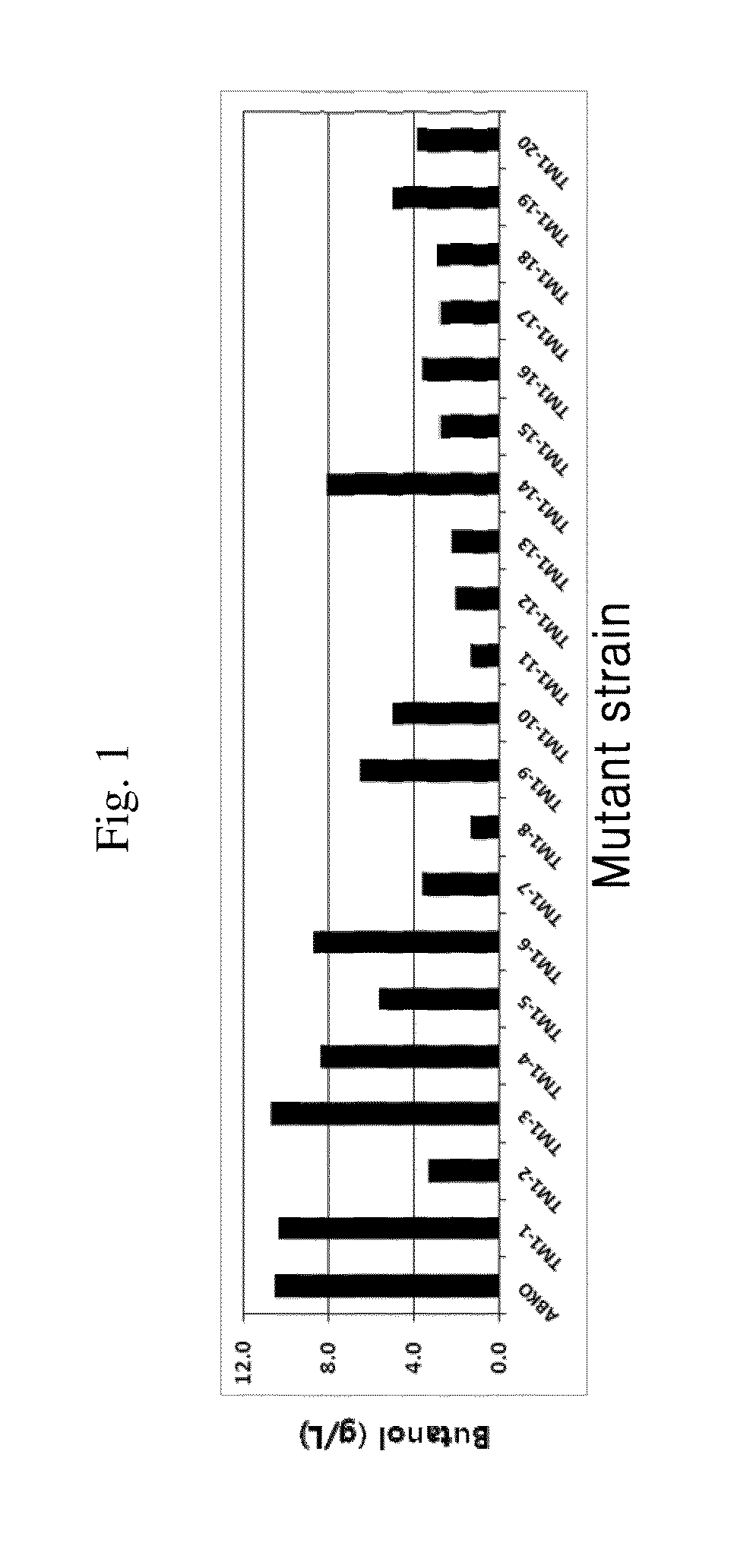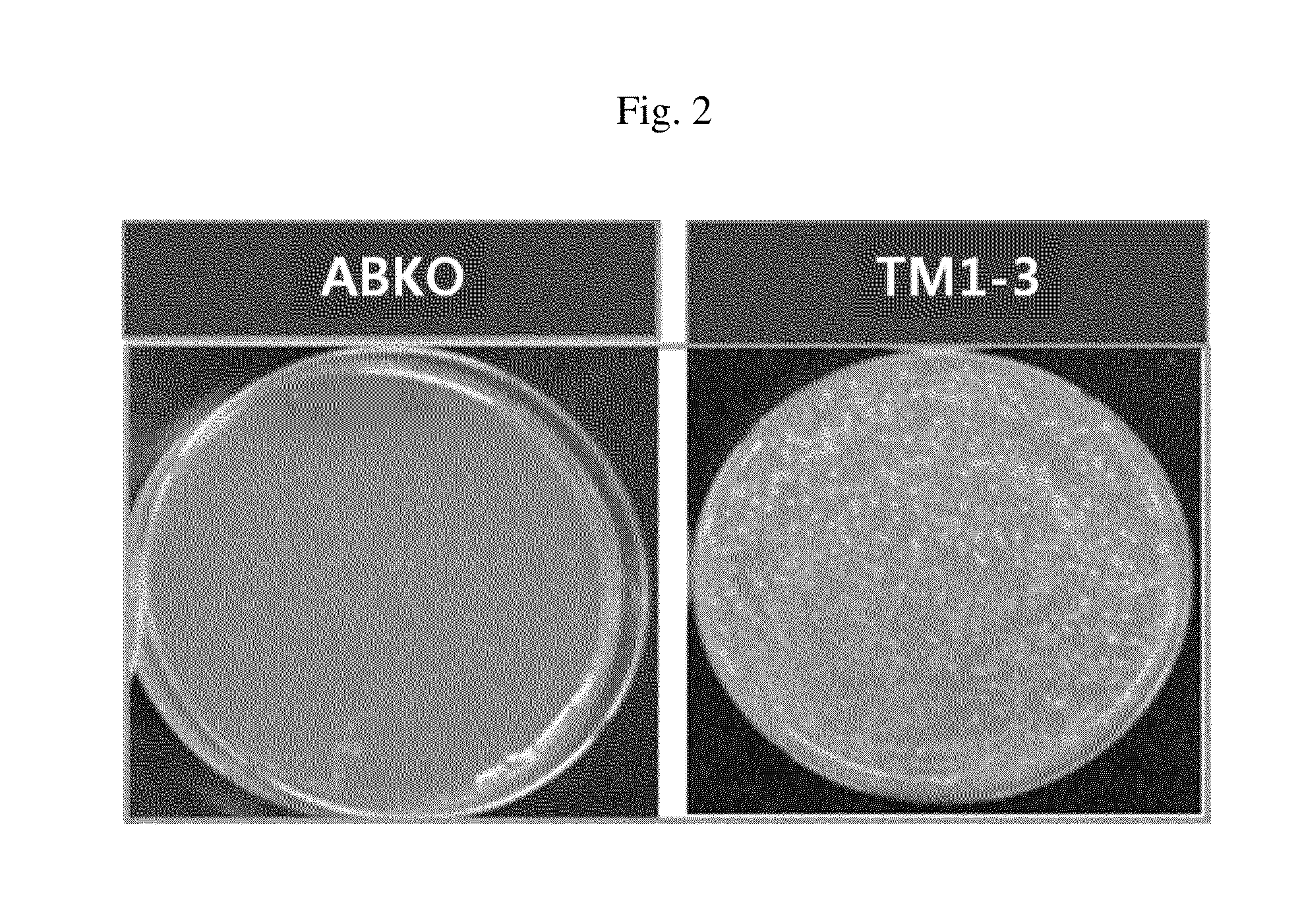Microorganism capable of simultaneous co-fermentation of mixed sugars and production method of butanol using the same
a technology of mixed sugar and microorganisms, which is applied in the direction of biofuels, enzymology, transferases, etc., can solve the problems of rising crop prices, raw material costs accounting for 60% of production costs, and use as raw materials, and achieve high selectivity
- Summary
- Abstract
- Description
- Claims
- Application Information
AI Technical Summary
Benefits of technology
Problems solved by technology
Method used
Image
Examples
experimental example 1
Construction of Strains Having Tolerance Against the Lignocellulosic Hydrolysate
[0071] Random Mutagenesis
[0072]ABKO strains were cultivated in 60 ml of liquid CGM (Clostridium Growth Medium) (0.75 g / L K2HPO4, 0.75 g / L KH2PO4, 0.7 g / L, MgSO4.7H2O, 0.017 g / L MnSO4.5H2O, 0.01 g / L, FeSO4.7H2O, 2 g / L (NH4)2SO2, 1 g / L NaCl, 2 g / L asparagine, 0.004 g / L p-aminobenzoic acid, 5 g / L yeast extract, 4.08 g / L CH3COONa.3H2O, and 80 g / L glucose) at 37° C. under anaerobic conditions until absorbance at 600 nm reached 0.5 (i.e., OD600=0.5). The culture solution was centrifuged at 7000 g for 10 minutes at 4° C. The cell pellets were washed with liquid CGM three times, and then re-suspended in 50 ml of liquid CGM. Methyl-N-Nitro-N-nitrosoguanidine (MNTG) was treated to have a final concentration of 50 μg / ml, and then left at 37° C. for 20 minutes to prepare libraries of mutants with a survival ratio of about 2.5%.
[0073] Selection of Strains Having Tolerance Against the Lignocellulosic Hydrolysate
[0074]...
experimental example 2
Selection of Strains Capable of Simultaneous Co-Fermentation of Xylose by Batch Cultivation
[0081] Random Mutagenesis
[0082]Among mutant strains prepared in , TM1-3 having the highest butanol productivity was employed in random mutagenesis, thereby constructing a library of the mutant. The method for constructing the mutant library was the same as that disclosed in .
[0083] Selection of Strains Capable of Simultaneous Co-Fermentation of Xylose and Glucose
[0084]Randomly mutated strains prepared in were diluted. The diluted strains were streaked on solid CGM prepared using 3 g / L of glucose and 3 g / L of xylose to form about 100 colonies. The random mutant strains formed on the streaked solid media were cultured under the same conditions as in for about 2 days. 20 colonies grown rapidly were selected, and designated as TM2-1 to TM2-20.
[0085] Evaluation of Butanol Productivity of Strains Capable of Simultaneous Co-Fermentation of Xylose and Glucose
[0086]Since the 20 random mutant strains ...
experimental example 3
Preparation of Strain TM2-1-C (E1AB)
[0095]Based on disclosure of International Patent Applications PCT / KR2013 / 001951 and PCT / KR2013 / 001954, pGS1-E1AB was prepared.
[0096]According to these publications, when adhE1 gene (aldehyde alcohol dehydrogenase) and cdAB gene (Co-A transferase) were overexpressed in strain ABKO (Clostridium acetobutylicum ATCC824 Δpta Δbuk), it was reported that ethanol productivity was reduced while butanol productivity was increased. Accordingly, simultaneous co-fermentation of mixed sugars in the lignocellulosic hydrolysate, and productivity of butanol, acetone and ethanol were evaluated by overexpressing adhE1 gene and ctfAB gene in the strain TM2-1-C.
[0097] Preparation of pGS1-E1AB Plasmid
[0098]Clostridium acetobutylicum ATCC824 was streaked on solid RCM, followed by anaerobic culturing for 24 hours. A colony selected from the streaked solid medium was cultured in 3 ml of a liquid culture medium for 18 hours, followed by centrifuging the culture solution t...
PUM
| Property | Measurement | Unit |
|---|---|---|
| Fraction | aaaaa | aaaaa |
| Fraction | aaaaa | aaaaa |
| Length | aaaaa | aaaaa |
Abstract
Description
Claims
Application Information
 Login to View More
Login to View More - R&D
- Intellectual Property
- Life Sciences
- Materials
- Tech Scout
- Unparalleled Data Quality
- Higher Quality Content
- 60% Fewer Hallucinations
Browse by: Latest US Patents, China's latest patents, Technical Efficacy Thesaurus, Application Domain, Technology Topic, Popular Technical Reports.
© 2025 PatSnap. All rights reserved.Legal|Privacy policy|Modern Slavery Act Transparency Statement|Sitemap|About US| Contact US: help@patsnap.com



